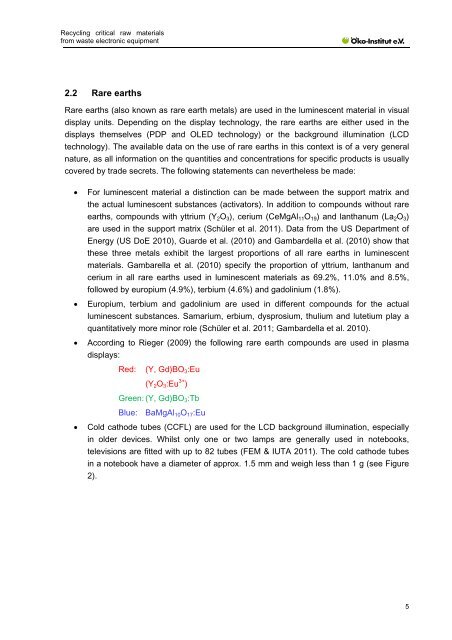Recycling critical raw materials from waste electronic equipment
Recycling critical raw materials from waste electronic equipment
Recycling critical raw materials from waste electronic equipment
You also want an ePaper? Increase the reach of your titles
YUMPU automatically turns print PDFs into web optimized ePapers that Google loves.
<strong>Recycling</strong> <strong>critical</strong> <strong>raw</strong> <strong>materials</strong><br />
<strong>from</strong> <strong>waste</strong> <strong>electronic</strong> <strong>equipment</strong><br />
2.2 Rare earths<br />
Rare earths (also known as rare earth metals) are used in the luminescent material in visual<br />
display units. Depending on the display technology, the rare earths are either used in the<br />
displays themselves (PDP and OLED technology) or the background illumination (LCD<br />
technology). The available data on the use of rare earths in this context is of a very general<br />
nature, as all information on the quantities and concentrations for specific products is usually<br />
covered by trade secrets. The following statements can nevertheless be made:<br />
� For luminescent material a distinction can be made between the support matrix and<br />
the actual luminescent substances (activators). In addition to compounds without rare<br />
earths, compounds with yttrium (Y2O3), cerium (CeMgAl11O19) and lanthanum (La2O3)<br />
are used in the support matrix (Schüler et al. 2011). Data <strong>from</strong> the US Department of<br />
Energy (US DoE 2010), Guarde et al. (2010) and Gambardella et al. (2010) show that<br />
these three metals exhibit the largest proportions of all rare earths in luminescent<br />
<strong>materials</strong>. Gambarella et al. (2010) specify the proportion of yttrium, lanthanum and<br />
cerium in all rare earths used in luminescent <strong>materials</strong> as 69.2%, 11.0% and 8.5%,<br />
followed by europium (4.9%), terbium (4.6%) and gadolinium (1.8%).<br />
� Europium, terbium and gadolinium are used in different compounds for the actual<br />
luminescent substances. Samarium, erbium, dysprosium, thulium and lutetium play a<br />
quantitatively more minor role (Schüler et al. 2011; Gambardella et al. 2010).<br />
� According to Rieger (2009) the following rare earth compounds are used in plasma<br />
displays:<br />
Red: (Y, Gd)BO3:Eu<br />
(Y2O3:Eu 3+ )<br />
Green: (Y, Gd)BO3:Tb<br />
Blue: BaMgAl10O17:Eu<br />
� Cold cathode tubes (CCFL) are used for the LCD background illumination, especially<br />
in older devices. Whilst only one or two lamps are generally used in notebooks,<br />
televisions are fitted with up to 82 tubes (FEM & IUTA 2011). The cold cathode tubes<br />
in a notebook have a diameter of approx. 1.5 mm and weigh less than 1 g (see Figure<br />
2).<br />
5

















